Yujie Li
End to End Autoencoder MLP Framework for Sepsis Prediction
Aug 26, 2025Abstract:Sepsis is a life threatening condition that requires timely detection in intensive care settings. Traditional machine learning approaches, including Naive Bayes, Support Vector Machine (SVM), Random Forest, and XGBoost, often rely on manual feature engineering and struggle with irregular, incomplete time-series data commonly present in electronic health records. We introduce an end-to-end deep learning framework integrating an unsupervised autoencoder for automatic feature extraction with a multilayer perceptron classifier for binary sepsis risk prediction. To enhance clinical applicability, we implement a customized down sampling strategy that extracts high information density segments during training and a non-overlapping dynamic sliding window mechanism for real-time inference. Preprocessed time series data are represented as fixed dimension vectors with explicit missingness indicators, mitigating bias and noise. We validate our approach on three ICU cohorts. Our end-to-end model achieves accuracies of 74.6 percent, 80.6 percent, and 93.5 percent, respectively, consistently outperforming traditional machine learning baselines. These results demonstrate the framework's superior robustness, generalizability, and clinical utility for early sepsis detection across heterogeneous ICU environments.
BLAST: Balanced Sampling Time Series Corpus for Universal Forecasting Models
May 23, 2025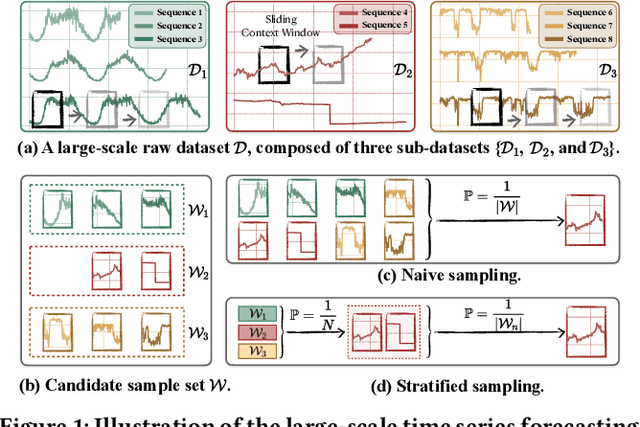
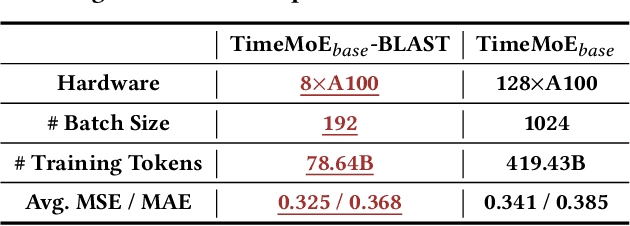
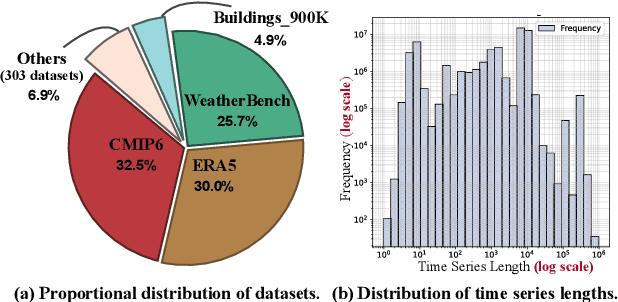
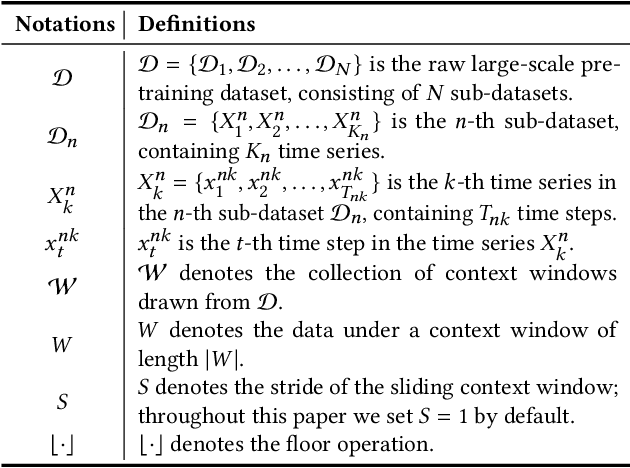
Abstract:The advent of universal time series forecasting models has revolutionized zero-shot forecasting across diverse domains, yet the critical role of data diversity in training these models remains underexplored. Existing large-scale time series datasets often suffer from inherent biases and imbalanced distributions, leading to suboptimal model performance and generalization. To address this gap, we introduce BLAST, a novel pre-training corpus designed to enhance data diversity through a balanced sampling strategy. First, BLAST incorporates 321 billion observations from publicly available datasets and employs a comprehensive suite of statistical metrics to characterize time series patterns. Then, to facilitate pattern-oriented sampling, the data is implicitly clustered using grid-based partitioning. Furthermore, by integrating grid sampling and grid mixup techniques, BLAST ensures a balanced and representative coverage of diverse patterns. Experimental results demonstrate that models pre-trained on BLAST achieve state-of-the-art performance with a fraction of the computational resources and training tokens required by existing methods. Our findings highlight the pivotal role of data diversity in improving both training efficiency and model performance for the universal forecasting task.
Improving Open-world Continual Learning under the Constraints of Scarce Labeled Data
Feb 28, 2025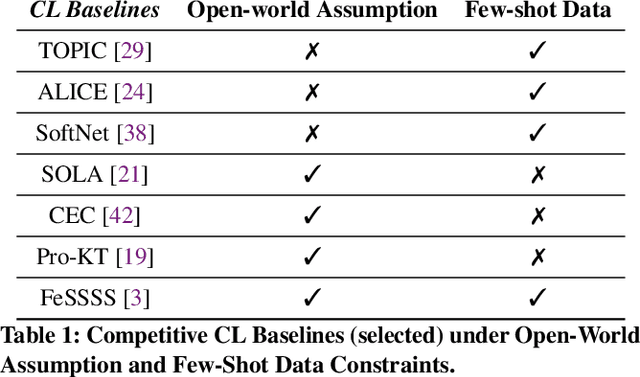
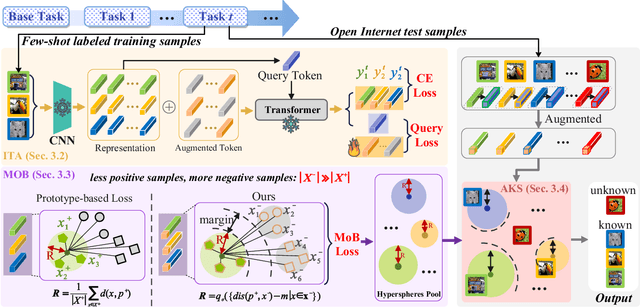
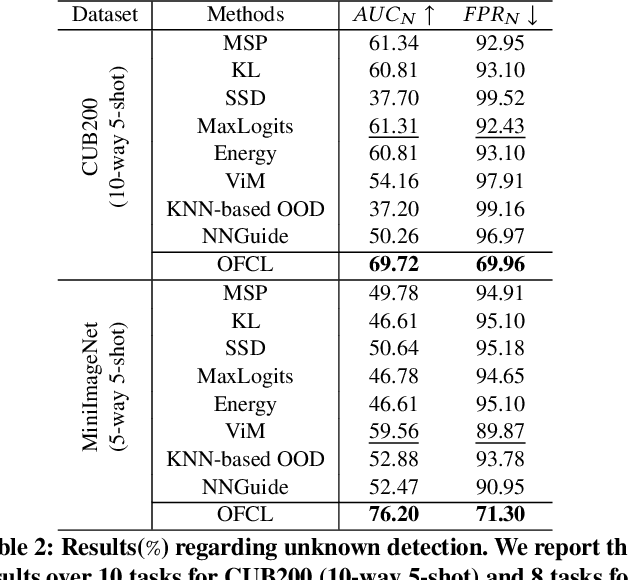
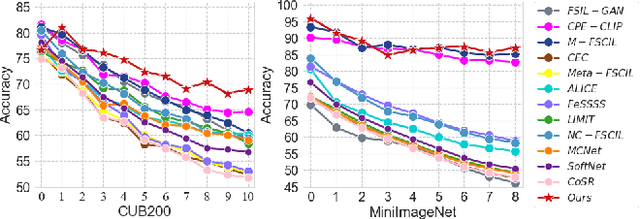
Abstract:Open-world continual learning (OWCL) adapts to sequential tasks with open samples, learning knowledge incrementally while preventing forgetting. However, existing OWCL still requires a large amount of labeled data for training, which is often impractical in real-world applications. Given that new categories/entities typically come with limited annotations and are in small quantities, a more realistic situation is OWCL with scarce labeled data, i.e., few-shot training samples. Hence, this paper investigates the problem of open-world few-shot continual learning (OFCL), challenging in (i) learning unbounded tasks without forgetting previous knowledge and avoiding overfitting, (ii) constructing compact decision boundaries for open detection with limited labeled data, and (iii) transferring knowledge about knowns and unknowns and even update the unknowns to knowns once the labels of open samples are learned. In response, we propose a novel OFCL framework that integrates three key components: (1) an instance-wise token augmentation (ITA) that represents and enriches sample representations with additional knowledge, (2) a margin-based open boundary (MOB) that supports open detection with new tasks emerge over time, and (3) an adaptive knowledge space (AKS) that endows unknowns with knowledge for the updating from unknowns to knowns. Finally, extensive experiments show the proposed OFCL framework outperforms all baselines remarkably with practical importance and reproducibility. The source code is released at https://github.com/liyj1201/OFCL.
Exploring Open-world Continual Learning with Knowns-Unknowns Knowledge Transfer
Feb 27, 2025



Abstract:Open-World Continual Learning (OWCL) is a challenging paradigm where models must incrementally learn new knowledge without forgetting while operating under an open-world assumption. This requires handling incomplete training data and recognizing unknown samples during inference. However, existing OWCL methods often treat open detection and continual learning as separate tasks, limiting their ability to integrate open-set detection and incremental classification in OWCL. Moreover, current approaches primarily focus on transferring knowledge from known samples, neglecting the insights derived from unknown/open samples. To address these limitations, we formalize four distinct OWCL scenarios and conduct comprehensive empirical experiments to explore potential challenges in OWCL. Our findings reveal a significant interplay between the open detection of unknowns and incremental classification of knowns, challenging a widely held assumption that unknown detection and known classification are orthogonal processes. Building on our insights, we propose \textbf{HoliTrans} (Holistic Knowns-Unknowns Knowledge Transfer), a novel OWCL framework that integrates nonlinear random projection (NRP) to create a more linearly separable embedding space and distribution-aware prototypes (DAPs) to construct an adaptive knowledge space. Particularly, our HoliTrans effectively supports knowledge transfer for both known and unknown samples while dynamically updating representations of open samples during OWCL. Extensive experiments across various OWCL scenarios demonstrate that HoliTrans outperforms 22 competitive baselines, bridging the gap between OWCL theory and practice and providing a robust, scalable framework for advancing open-world learning paradigms.
Order-Robust Class Incremental Learning: Graph-Driven Dynamic Similarity Grouping
Feb 27, 2025Abstract:Class Incremental Learning (CIL) requires a model to continuously learn new classes without forgetting previously learned ones. While recent studies have significantly alleviated the problem of catastrophic forgetting (CF), more and more research reveals that the order in which classes appear have significant influences on CIL models. Specifically, prioritizing the learning of classes with lower similarity will enhance the model's generalization performance and its ability to mitigate forgetting. Hence, it is imperative to develop an order-robust class incremental learning model that maintains stable performance even when faced with varying levels of class similarity in different orders. In response, we first provide additional theoretical analysis, which reveals that when the similarity among a group of classes is lower, the model demonstrates increased robustness to the class order. Then, we introduce a novel \textbf{G}raph-\textbf{D}riven \textbf{D}ynamic \textbf{S}imilarity \textbf{G}rouping (\textbf{GDDSG}) method, which leverages a graph coloring algorithm for class-based similarity grouping. The proposed approach trains independent CIL models for each group of classes, ultimately combining these models to facilitate joint prediction. Experimental results demonstrate that our method effectively addresses the issue of class order sensitivity while achieving optimal performance in both model accuracy and anti-forgetting capability. Our code is available at https://github.com/AIGNLAI/GDDSG.
UniRS: Unifying Multi-temporal Remote Sensing Tasks through Vision Language Models
Dec 30, 2024Abstract:The domain gap between remote sensing imagery and natural images has recently received widespread attention and Vision-Language Models (VLMs) have demonstrated excellent generalization performance in remote sensing multimodal tasks. However, current research is still limited in exploring how remote sensing VLMs handle different types of visual inputs. To bridge this gap, we introduce \textbf{UniRS}, the first vision-language model \textbf{uni}fying multi-temporal \textbf{r}emote \textbf{s}ensing tasks across various types of visual input. UniRS supports single images, dual-time image pairs, and videos as input, enabling comprehensive remote sensing temporal analysis within a unified framework. We adopt a unified visual representation approach, enabling the model to accept various visual inputs. For dual-time image pair tasks, we customize a change extraction module to further enhance the extraction of spatiotemporal features. Additionally, we design a prompt augmentation mechanism tailored to the model's reasoning process, utilizing the prior knowledge of the general-purpose VLM to provide clues for UniRS. To promote multi-task knowledge sharing, the model is jointly fine-tuned on a mixed dataset. Experimental results show that UniRS achieves state-of-the-art performance across diverse tasks, including visual question answering, change captioning, and video scene classification, highlighting its versatility and effectiveness in unifying these multi-temporal remote sensing tasks. Our code and dataset will be released soon.
Ordering-Based Causal Discovery for Linear and Nonlinear Relations
Oct 08, 2024



Abstract:Identifying causal relations from purely observational data typically requires additional assumptions on relations and/or noise. Most current methods restrict their analysis to datasets that are assumed to have pure linear or nonlinear relations, which is often not reflective of real-world datasets that contain a combination of both. This paper presents CaPS, an ordering-based causal discovery algorithm that effectively handles linear and nonlinear relations. CaPS introduces a novel identification criterion for topological ordering and incorporates the concept of "parent score" during the post-processing optimization stage. These scores quantify the strength of the average causal effect, helping to accelerate the pruning process and correct inaccurate predictions in the pruning step. Experimental results demonstrate that our proposed solutions outperform state-of-the-art baselines on synthetic data with varying ratios of linear and nonlinear relations. The results obtained from real-world data also support the competitiveness of CaPS. Code and datasets are available at https://github.com/E2real/CaPS.
LightWeather: Harnessing Absolute Positional Encoding to Efficient and Scalable Global Weather Forecasting
Aug 19, 2024



Abstract:Recently, Transformers have gained traction in weather forecasting for their capability to capture long-term spatial-temporal correlations. However, their complex architectures result in large parameter counts and extended training times, limiting their practical application and scalability to global-scale forecasting. This paper aims to explore the key factor for accurate weather forecasting and design more efficient solutions. Interestingly, our empirical findings reveal that absolute positional encoding is what really works in Transformer-based weather forecasting models, which can explicitly model the spatial-temporal correlations even without attention mechanisms. We theoretically prove that its effectiveness stems from the integration of geographical coordinates and real-world time features, which are intrinsically related to the dynamics of weather. Based on this, we propose LightWeather, a lightweight and effective model for station-based global weather forecasting. We employ absolute positional encoding and a simple MLP in place of other components of Transformer. With under 30k parameters and less than one hour of training time, LightWeather achieves state-of-the-art performance on global weather datasets compared to other advanced DL methods. The results underscore the superiority of integrating spatial-temporal knowledge over complex architectures, providing novel insights for DL in weather forecasting.
Struggle with Adversarial Defense? Try Diffusion
Apr 12, 2024Abstract:Adversarial attacks induce misclassification by introducing subtle perturbations. Recently, diffusion models are applied to the image classifiers to improve adversarial robustness through adversarial training or by purifying adversarial noise. However, diffusion-based adversarial training often encounters convergence challenges and high computational expenses. Additionally, diffusion-based purification inevitably causes data shift and is deemed susceptible to stronger adaptive attacks. To tackle these issues, we propose the Truth Maximization Diffusion Classifier (TMDC), a generative Bayesian classifier that builds upon pre-trained diffusion models and the Bayesian theorem. Unlike data-driven classifiers, TMDC, guided by Bayesian principles, utilizes the conditional likelihood from diffusion models to determine the class probabilities of input images, thereby insulating against the influences of data shift and the limitations of adversarial training. Moreover, to enhance TMDC's resilience against more potent adversarial attacks, we propose an optimization strategy for diffusion classifiers. This strategy involves post-training the diffusion model on perturbed datasets with ground-truth labels as conditions, guiding the diffusion model to learn the data distribution and maximizing the likelihood under the ground-truth labels. The proposed method achieves state-of-the-art performance on the CIFAR10 dataset against heavy white-box attacks and strong adaptive attacks. Specifically, TMDC achieves robust accuracies of 82.81% against $l_{\infty}$ norm-bounded perturbations and 86.05% against $l_{2}$ norm-bounded perturbations, respectively, with $\epsilon=0.05$.
URLBERT:A Contrastive and Adversarial Pre-trained Model for URL Classification
Feb 18, 2024Abstract:URLs play a crucial role in understanding and categorizing web content, particularly in tasks related to security control and online recommendations. While pre-trained models are currently dominating various fields, the domain of URL analysis still lacks specialized pre-trained models. To address this gap, this paper introduces URLBERT, the first pre-trained representation learning model applied to a variety of URL classification or detection tasks. We first train a URL tokenizer on a corpus of billions of URLs to address URL data tokenization. Additionally, we propose two novel pre-training tasks: (1) self-supervised contrastive learning tasks, which strengthen the model's understanding of URL structure and the capture of category differences by distinguishing different variants of the same URL; (2) virtual adversarial training, aimed at improving the model's robustness in extracting semantic features from URLs. Finally, our proposed methods are evaluated on tasks including phishing URL detection, web page classification, and ad filtering, achieving state-of-the-art performance. Importantly, we also explore multi-task learning with URLBERT, and experimental results demonstrate that multi-task learning model based on URLBERT exhibit equivalent effectiveness compared to independently fine-tuned models, showing the simplicity of URLBERT in handling complex task requirements. The code for our work is available at https://github.com/Davidup1/URLBERT.
 Add to Chrome
Add to Chrome Add to Firefox
Add to Firefox Add to Edge
Add to Edge